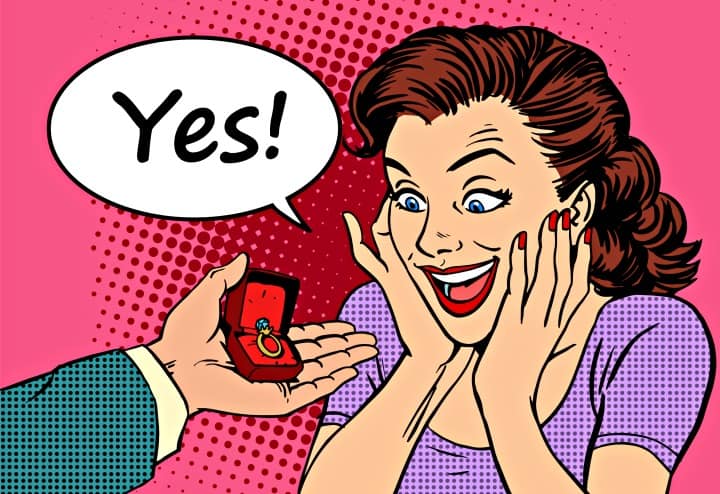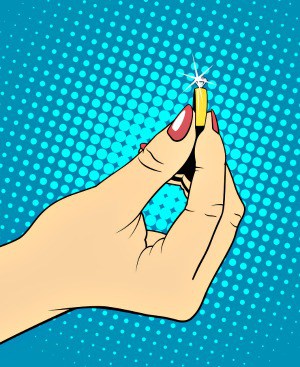Proposing Marriage? 5 Cost-Cutting Tips for an Engagement Ring

Just because you want her to say “I do” doesn’t mean you need to cash out your retirement savings to pay for the engagment ring.
With a little creativity, a dash of flexibility and a bit of planning, selecting an engagement ring can be comfortable for your wallet.
The key to keeping the ring from rivaling your mortgage is to first lay out expectations and limits before you begin shopping, says Danielle Mainas Etra, founder of Little Bird engagement ring consultants in San Francisco.
“It’s really important is to set a number you are really comfortable with and stick to it,” Mainas Etra says.
She says you want to buy a ring with a price tag that will let you look yourself in the mirror without guilt later and that you are comfortable sharing with your partner and not be embarrassed.
Sounds easy, but how do you do that? These four tips from insuranceQuotes may help:
1. Think outside the big box stores
Once you have a price in mind, you can begin shopping at all the obvious places — the mall, the major jewelers, the online ring giants, even chain superstores. But Mainas Etra says bargain hunters shouldn’t stop there. They should also head to some more nontraditional locations.
One place many people don’t think to shop is with small, independent studio designers who might not have a storefront yet. Finding those can be as simple as getting word-of-mouth recommendations from your personal network, but using tools, such as Instagram, with creative hash tag searches can also open the door to the boutique designers. No matter what engagement ring you choose for your loved one, it may be a good idea to decide whether or not jewelry insurance is worth it?
RELATED: 4 Insurance Musts for Getting Married or Divorced
The reason why a boutique designer can save you money is that they don’t have the large overhead of a storefront. Many also are eager to work for less money as they are starting out and making a name for themselves.
Antique rings are also an option that shouldn’t be overlooked. Whether it is from a pawn shop or an antique store, second-hand rings typically come in at a much lower price point for what you are getting.
“With the antiques, you often find things that are beautiful and unique that if you tried to make now wouldn’t look the same and would cost a whole lot more,” says Mainas Etra.
If you feel weird about wearing an old diamond, Mainas Etra said to remember that all diamonds, by definition, are old.
“People need to realize, there are not ghosts in their diamond. The stone has been around for millions of years,” Mainas Etra says.
Before you get carried away by a second-hand ring, though, Jessica Burke, publisher of New Orleans Weddings Magazine warns that it is a good idea to bring in a professional to weigh in.
“If buying any fine jewelry, always make sure that it is a reputable source and that you’re getting what you pay for,” Burke says. “You want to have an appraisal and know the details of what you’re getting.”
2. Create an illusion
No matter where you chose to buy your diamond, everyone knows that it is the four Cs that rule — right? Not so fast. Mainas Etra warns that while color, clarity, cut and carat are essential, shopping smart within your constraints can lead to some real values.
For example, once you pick which carat weight you are looking for, it is often wise to look a small fraction smaller.
 “If you come in right below one of the major demarcations, you are going to find real values,” Mainas Etra says. “Prices rise exponentially as they raise the next benchmark weight.”
“If you come in right below one of the major demarcations, you are going to find real values,” Mainas Etra says. “Prices rise exponentially as they raise the next benchmark weight.”
For example, going from a 1.95 carat to a 2 carat may mean you are going to shell out thousands more.
And in the end, nobody walks around town saying they have a 1.95-carat diamond — they say they have a two-carat stone. Nobody is going to pop it on the scale to double check.
“We are super into rounding up after we have the ring, but before that we get obsessed with the scale, and that is completely unnecessary,” Mainas Etra says.
Another surprising measurement detail comes down to the limits of human perception.
“The human eye can detect a quarter of a millimeter difference in terms of the diameter of a stone,” Mainas Etra says.
For example, she says we can tell the difference between 8 and 8.25 millimeters, but smaller increments slip by our perception. That means you shouldn’t pay a cent more for a stone unless you get at least a 0.25 millimeter increase.
“This can mean thousands of dollars for a difference you can’t see,” Mainas Etra says.
Another trick is to set your diamond and surround it with a halo of smaller diamonds. The trick to pulling that off, though, is to look for non-traditional ways of building that halo.
Paying attention to other details in the setting can also pay off. Kim Sayatovic with Belladeux Event Design says that going with a less-precious metal can often make a lot of sense.
“Think about the functionality of the metal and what type of environment your ring will be worn,” Sayatovic says. “Softer metals such as gold may not work well for a chef, but a harder metal like platinum may. Even modern metals may work, like titanium, and can help save money.”
Sayatovic says that because the karat is a description of the metal purity and not necessarily an indicator of the “best,” you should focus on the individual wearing it.
“Twenty-four-karat gold has the fewest impurities, but it is also the softest of the gold. You can get a lower karat, stronger and more durable, for less money and it will be just as functional and pretty,” Sayatovic says.
Picking a stone with minor imperfections, especially in places that you can’t see once it is set, is another way to trim costs without compromising, says Michael Han, president of The Wedding Ring Shop in Honolulu.
“You can get a great value in a diamond that has inclusions (flaws) that are not noticeable to the naked eye but very brilliant at the same time,” Han says.
3. Ditch the traditional diamond
Burke says that while nearly a century of marketing has dictated that only a diamond will do for an engagement ring, that doesn’t mean we have to bow to the pressure.
“Diamonds are not a ‘must’ by any means,” Burke says. “They are however traditional — at least for the last 80 years or so.”
Some diamonds also come with political sensitivities and with preconceptions some people would not be comfortable wearing on their fingers.
“The stone, if there is one, should reflect the wearer,” Sayatovic says. “If the wearer would never buy a diamond, then the engagement ring should not have one.”
While Mainas Etra agrees that diamonds are far from a must-have stone, from a practical standpoint, you do need a stone that is hard enough to stand up to the test of time and would be less likely to chip or break under daily wearing conditions.
 She suggest sapphire as a great option.
She suggest sapphire as a great option.
Another option is the diamond simulant moissanite, especially for people who want a huge stone but don’t have the budget to match their tastes.
“If it is all about the size, moissanite is a good option,” Mainas Etra says.
Moissanite is a naturally occurring stone made of silicone and carbon that looks very similar to a diamond but that comes at a fraction of the cost.
Then there are lab-created diamonds, which are chemically identical to natural diamonds, but as their name implies, they are grown in a lab, not deep within the earth.
The trick to buying a lab-created diamond, says Mainas Etra, is to upgrade your color and clarity as high as you can afford.
“You really want to be in the colorless range. You can’t take the specs for a natural diamond and put it on a lab cut — the looks just aren’t the same,” Mainas Etra says. She says the lower-grade colors come across as muddied.
A nice middle ground between using a diamond alternative and breaking the bank is to chose a classic sized alternative stone, say a 1-carat moissanite. That way, when you are in a better financial position later in life, you can swap out the alternative stone with a natural diamond and keep the sentimental setting.
Whatever diamond substitute you chose, make sure to let your partner in on it, Han says.
“Never buy your fiancée a synthetic or simulated diamond and not tell the truth. It happens way too often and it always ends up badly.”
4. Look to your family for savings
One of the more obvious places to save is to tap into your existing heirlooms and family jewelry collections.
“Having an existing family ring or other piece of jewelry reset into an engagement ring is a wonderful sentimental touch,” Burke says. “The piece will bring with it the love from the previous wearers, while the new setting allows it to be personalized for the new relationship and wearer.”
Without having to pay for the stone, you can then invest the savings into the rest of the ring.
CHECK OUT: Tips for Renting Out Your Home to Vacationers
“It might even be a half-carat stone, but you can then sink the savings into the setting and make a ring that is so cool,” Mainas Etra says.
And don’t forget about the rest of the jewelry box.
“So many people have a pair of diamond earrings that they lost one of them. Use that and make something really cool around it,” Mainas Etra says.
Of course, if the new recipient loves the original ring, there is nothing wrong with keeping it exactly as it is either, Burke says.
That said, just because the stone is an heirloom, doesn’t mean it is priceless.
“I have had folks who brought in grandma’s ring, and it turns out it wasn’t a real diamond. That kind of thing happens,” Mainas Etra says.
5. Rent a ring
The final thing you want to avoid is overpaying with the hope that you might recoup your investment later by selling the stone.
“Jewelry is a terrible investment,” Mainas Etra says. “You buy it for a whole lot of emotional, personal and sentimental reasons, but resale value is never one of them.”
So, broken engagements, diamonds inherited from family, and the like really won’t fetch much on the secondary market.
One way to dodge that risk, believe it or not, is to rent the ring in some circumstances.
“Prospective proposers can rent a ring for the actual proposal so they’re not showing up empty handed and then bring their fiancée in to the jewelers afterwards to select the ring design they really want,” Burke said. “This assures that everyone is happy in the end.”
If your heart is set on a specific stone, but your budget just can’t get there, another option is to ask for help.
“I’ve had a couple ask their friends to gift them money as a wedding gift so they could buy their diamond wedding rings,” Han says.
Finally, once you have invested your time, effort, tears, and most importantly, your money, into a ring, don’t forget about protecting that investment.
“As a side note, personal jewelry insurance is incredibly affordable and is something that most couples don’t even think about,” Burke says. If your engagement ring is more affordable it may be covered under a standard homeowners insurance policy.
